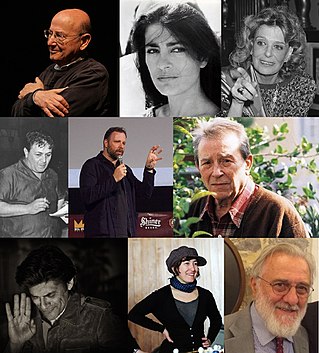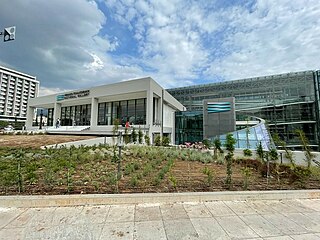
The Greek pavilion houses Greece's national representation during the Venice Biennale arts festivals.

The Greek pavilion houses Greece's national representation during the Venice Biennale arts festivals.
The Venice Biennale is an international art biennial exhibition held in Venice, Italy. Often described as "the Olympics of the art world", participation in the Biennale is a prestigious event for contemporary artists. The festival has become a constellation of shows: a central exhibition curated by that year's artistic director, national pavilions hosted by individual nations, and independent exhibitions throughout Venice. The Biennale parent organization also hosts regular festivals in other arts: architecture, dance, film, music, and theater. [1]
Outside of the central, international exhibition, individual nations produce their own shows, known as pavilions, as their national representation. Nations that own their pavilion buildings, such as the 30 housed on the Giardini, are responsible for their own upkeep and construction costs as well. Nations without dedicated buildings create pavilions in venues throughout the city. [1]


Architect Y. Papandréou designed the pavilion, which was built between 1933 and 1934. Brenno Del Giudice, who led the Biennale's Sant'Elena expansion, also collaborated on the project. The pavilion was built in a neo-Byzantine style, putting in focus the Byzantine dimension of Hellenism, a very engaging issue in Greece at that time. [2] The building's simple layout includes a T-shaped hall. Greek and diamond patterns adorn the brickwork, and Greco-Byzantine round arches line the portico. The word "GRECIA" is written on marble above the entrance.
The Greek pavilion is administered by the Greek Ministry of Culture, which is as well responsible for organising the Greek participation during the Venice Biennale International Art Exhibition. [3]
The Greek pavilion is located at the Giardini of the Venice Biennale. Visitors can reach the Greek pavilion either through the main entrance, making it one of the last pavilions in their walking route, or through the back entrance of the Giardini, with the Greek pavilion being the first in sight. The building is accessible either via its frontal main entrance, using the stairs, or through a ramp at the right side of the building that leads to the back entrance of the pavilion. [4]
This section needs additional citations for verification .(November 2024) |
Source: [5]
Source: [7]

The cinema of Greece has a long and rich history. Though hampered at times by war or political instability, the Greek film industry dominates the domestic market and has experienced international success. Characteristics of Greek cinema include a dynamic plot, strong character development and erotic themes. Two Greek films, Missing (1982) and Eternity and a Day (1998), have won the Palme d'Or at the Cannes Film Festival. Five Greek films have received nominations for the Academy Award for Best Foreign Language Film.

The Greece men's national basketball team represents Greece in international basketball. They are controlled by the Hellenic Basketball Federation, the governing body for basketball in Greece. Greece is currently ranked 13th in the FIBA World Ranking.

Nikos Engonopoulos was a Greek painter and poet. He is one of the most important members of "Generation of the '30s", as well as a major representative of the surrealist movement in Greece. His work as a writer also includes critique and essays.

Yiannis Moralis was an important Greek visual artist and part of the so-called "Generation of the '30s". He is a person who carried weight in many fields and found himself to be equally au courant. Furthermore, he exhibited a strong sense of responsibility when it came to confronting modern day problems. His art is distinct for the esoteric nature of its forms and its capacity and ability to suggest space.

The National Gallery is an art museum located on Vasilissis Sofias avenue in the Pangrati district, Athens, Greece. It is devoted to Greek and European art from the 14th century to the 20th century.
The following is a history of the basketball players and head coaches that have competed for the Greece men's national basketball team, at all of the major international basketball tournaments.

The British pavilion houses Great Britain's national representation during the Venice Biennale arts festivals.

The German pavilion houses Germany's national representation during the Venice Biennale arts festivals.

The Austrian pavilion is a national pavilion of the Venice Biennale. It houses Austria's official representation during the Biennale.

The national pavilions host each participant nation's official representation during the Venice Biennale, an international art biennial exhibition held in Venice, Italy. Some countries own pavilion buildings in the Giardini della Biennale while others rent buildings throughout the city, but each country controls its own selection process and production costs.

The Romanian pavilion houses Romania's national representation during the Venice Biennale arts festivals.

The Dutch pavilion houses the Netherlands's national representation during the Venice Biennale arts festivals.